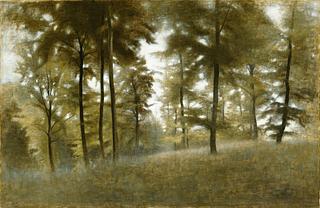Vilhelm Hammershøi (1864–1916)
Young Beech Forest, Frederiksværk, 1904
Oil on canvas
47 x 73 cm
Inventory number B 308
Vilhelm Hammershøi painted Young Beech Forest, Frederiksværk while summering in Arresødal near Frederiksværk in North Zealand in 1904.
Unlike his open landscapes (7/2016), painted while taking up a position at a more conventional distance from his chosen subject, Hammershøi has here elected to depict a section of the forest in which the most important elements are the slender tree trunks and their fuzzy foliage. The forest floor in the foreground of the picture is blurred and hazy, creating the feeling that one cannot enter the space shown here at all. The beech forest seems alien to us, and even though the subject is firmly inscribed in the Danish Golden Age tradition, it does not testify to National Romantic sensibilities of any kind.
With Young Beech Forest, Frederiksværk, Hammershøi does not follow his usual transversal compositional principle in which his subject matter runs parallel to the picture plane. Instead, he has worked with slightly sloping and dynamic lines: the slender tree trunks and the lush forest floor slope downwards to the left in a diagonal, depicting an – for Hammershøi – unusual point of view. The beech forest is represented without details, without any road and without traces of humans or animals. Everything has been omitted in favour of rendering the light falling in between the trees from behind, the backlight adding a misty, almost dreamlike mood to the scene.
Unlike his open landscapes (7/2016), painted while taking up a position at a more conventional distance from his chosen subject, Hammershøi has here elected to depict a section of the forest in which the most important elements are the slender tree trunks and their fuzzy foliage. The forest floor in the foreground of the picture is blurred and hazy, creating the feeling that one cannot enter the space shown here at all. The beech forest seems alien to us, and even though the subject is firmly inscribed in the Danish Golden Age tradition, it does not testify to National Romantic sensibilities of any kind.
With Young Beech Forest, Frederiksværk, Hammershøi does not follow his usual transversal compositional principle in which his subject matter runs parallel to the picture plane. Instead, he has worked with slightly sloping and dynamic lines: the slender tree trunks and the lush forest floor slope downwards to the left in a diagonal, depicting an – for Hammershøi – unusual point of view. The beech forest is represented without details, without any road and without traces of humans or animals. Everything has been omitted in favour of rendering the light falling in between the trees from behind, the backlight adding a misty, almost dreamlike mood to the scene.
Published in
Published in
Fortegnelse over arbejder af Vilhelm Hammershøi, [2], Kunstforeningen April-Maj 1916, København 1916, cat.no. 44, p. 6;
Sophus Michaëlis and Alfred Bramsen: Vilhelm Hammershøi. Kunstneren og hans værk, København 1918, cat.no. 262, p. 103;
Alfred Bramsen: Udvalg af Vilh. Hammershøis arbejder, København 1930, cat.no. 21, p. 9;
Erik Zahle: ”Billedkunst” in C.L. Davids Samling. Nogle Studier, [1], København 1948, p. 207;
Knud Voss and Verner Aspenström: Vilhelm Hammershøi, Prins Eugens Waldemarsudde, Stockholm 1976, cat.no. 21;
Hanne Finsen, Inge Vibeke Raaschou-Nielsen: Vilhelm Hammershøi: en retrospektiv udstilling, Ordrupgaard, Charlottenlund 1981, cat.no. 99, p. 123;
Poul Vad i Kjeld von Folsach and Nana Lund (eds.): Dansk kunst i Davids Samling – fra Philipsen til Saxbo, København 1995, cat.no. 34, pp. 98-99;
Anne-Birgitte Fonsmark et al.: Vilhelm Hammershøi, 1864-1916. Danish painter of solitude and light, Ordrupgaard, Charlottenlund, Musée d’Orsay, Paris, Solomon R. Guggenheim Museum, New York 1998, cat.no. 35, pp. 96-97;
Lena Boëthius, Görel Cavalli-Björkman (eds.): Vilhelm Hammershøi, Göteborg Konstmuseum and Stockholm Nationalmuseum, Göteborg 1999, p. 34;
Felix Krämer, Ulrich Luckhardt, Barbara Ludwig: Vilhelm Hammershøi, Hamburger Kunsthalle, Hamburg 2003, cat.no. 34, pp. 22, 64, 154;
Poul Vad: Hammershøi. Værk og liv, København 2003, 5. ed., pp. 290, 401;
Tone Sinding Steinsvik, Ida Lorentzen, Bente Scavenius: Den forunderlige stillheten: Ida Lorentzen (f.1951), Vilhelm Hammershøi (1864-1916), Stiftelsen Modums Blaafarveværk, Modum 2005, cat.no. 53, p. 82;
Henrik Wivel: Hammershøi i Davids Samling, København 2017, pp. 72-73;
Annette Rosenvold Hvidt and Gertrud Oelsner: Vilhelm Hammershøi. På sporet af det åbne billede, København 2018, pp. 212-213;
Sophus Michaëlis and Alfred Bramsen: Vilhelm Hammershøi. Kunstneren og hans værk, København 1918, cat.no. 262, p. 103;
Alfred Bramsen: Udvalg af Vilh. Hammershøis arbejder, København 1930, cat.no. 21, p. 9;
Erik Zahle: ”Billedkunst” in C.L. Davids Samling. Nogle Studier, [1], København 1948, p. 207;
Knud Voss and Verner Aspenström: Vilhelm Hammershøi, Prins Eugens Waldemarsudde, Stockholm 1976, cat.no. 21;
Hanne Finsen, Inge Vibeke Raaschou-Nielsen: Vilhelm Hammershøi: en retrospektiv udstilling, Ordrupgaard, Charlottenlund 1981, cat.no. 99, p. 123;
Poul Vad i Kjeld von Folsach and Nana Lund (eds.): Dansk kunst i Davids Samling – fra Philipsen til Saxbo, København 1995, cat.no. 34, pp. 98-99;
Anne-Birgitte Fonsmark et al.: Vilhelm Hammershøi, 1864-1916. Danish painter of solitude and light, Ordrupgaard, Charlottenlund, Musée d’Orsay, Paris, Solomon R. Guggenheim Museum, New York 1998, cat.no. 35, pp. 96-97;
Lena Boëthius, Görel Cavalli-Björkman (eds.): Vilhelm Hammershøi, Göteborg Konstmuseum and Stockholm Nationalmuseum, Göteborg 1999, p. 34;
Felix Krämer, Ulrich Luckhardt, Barbara Ludwig: Vilhelm Hammershøi, Hamburger Kunsthalle, Hamburg 2003, cat.no. 34, pp. 22, 64, 154;
Poul Vad: Hammershøi. Værk og liv, København 2003, 5. ed., pp. 290, 401;
Tone Sinding Steinsvik, Ida Lorentzen, Bente Scavenius: Den forunderlige stillheten: Ida Lorentzen (f.1951), Vilhelm Hammershøi (1864-1916), Stiftelsen Modums Blaafarveværk, Modum 2005, cat.no. 53, p. 82;
Henrik Wivel: Hammershøi i Davids Samling, København 2017, pp. 72-73;
Annette Rosenvold Hvidt and Gertrud Oelsner: Vilhelm Hammershøi. På sporet af det åbne billede, København 2018, pp. 212-213;
Paintings and drawings
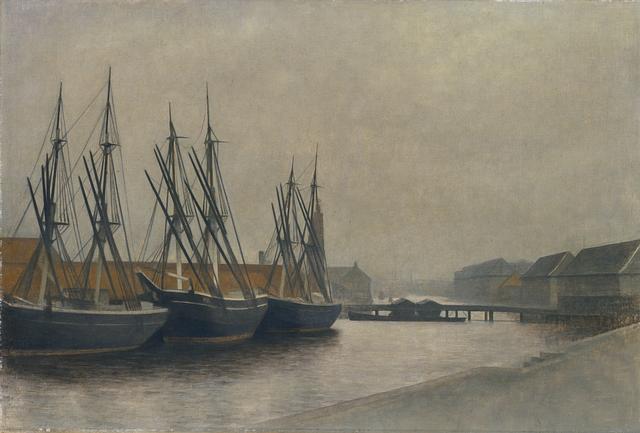
Vilhelm Hammershøi (1864–1916)
Three Ships, Christianshavn Canal, 1905
Oil on canvas
Three Ships, Christianshavn Canal, 1905
Oil on canvas
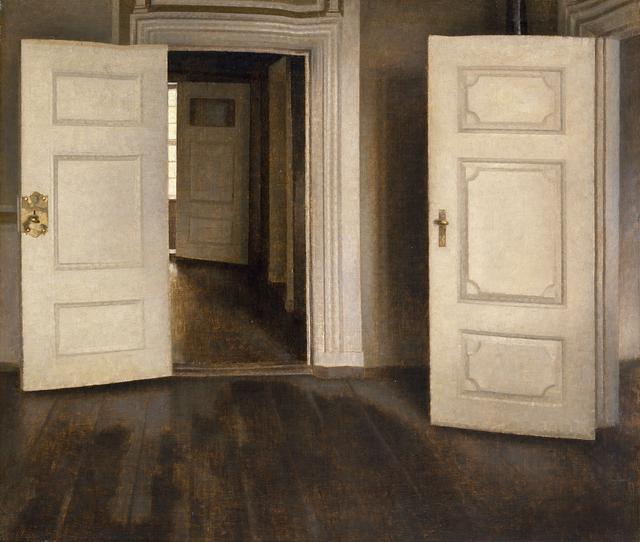
Vilhelm Hammershøi (1864–1916)
Open Doors, 1905
Oil on canvas
Open Doors, 1905
Oil on canvas
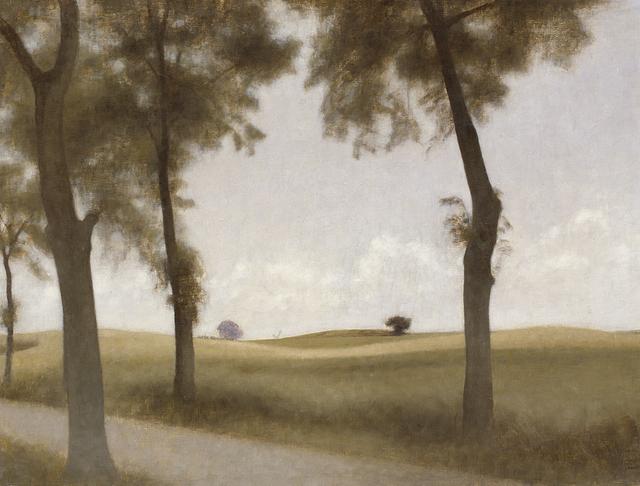
Vilhelm Hammershøi (1864–1916)
The Rowan Avenue at Snekkersten, 1906
Oil on canvas
The Rowan Avenue at Snekkersten, 1906
Oil on canvas
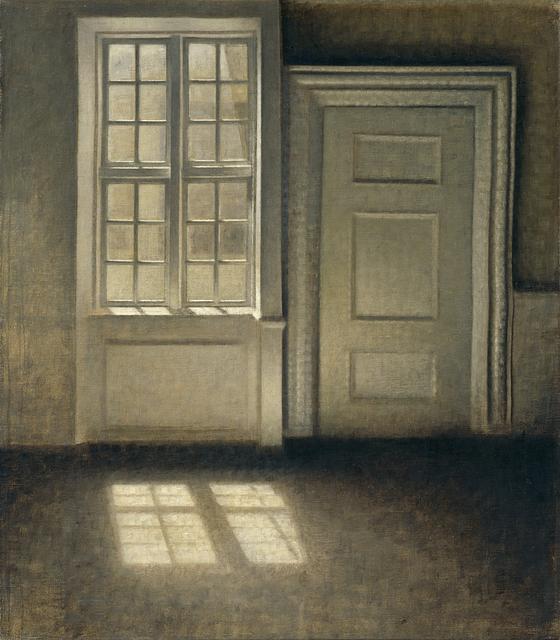
Vilhelm Hammershøi (1864–1916)
Sitting Room. Study in Sunlight, 1906
Oil on canvas
Sitting Room. Study in Sunlight, 1906
Oil on canvas
